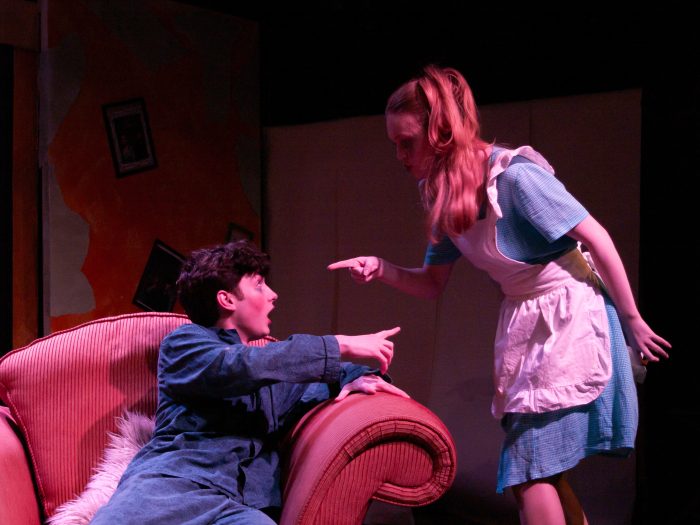During the production’s preset, the well-awaited ‘Jellyfish’ (Billy Truscott) was running around on stage. Dressed in a suit and tie – and of course, the head of a Jellyfish – he appeared to be stuck in a cycle of working his way around the stage, interacting with every appliance in a frenzied state before collapsing onto an armchair.
This play gives an insight into the lives of Willow, played by Ellie Carrier, and Smiff, played by Tommy Haines. They’re an equally tempestuous and irritable pair, whose relationship is close to breaking point. Watching the play was like watching a continuous argument between the two of them, as they tried to patch up a broken wall (broken by – you guessed it – the Jellyfish) in their home.
Both of their characters saw big transformations. At the beginning of the play, Smiff did most of his scenes in pyjamas, but midway through, he burst through the door in a three-piece suit, the jacket of which was covered in bird excrement. He was filled with pride from his “new job, new suit, new shoes” and suddenly became exhilarated by corporate life despite not having a clue what to do with it.
In a tight 60-minute performance, Willow was able to capture all the stages of a person who was falling into hysteria as a consequence of feeling isolated and “used” within her own home. In particular, her monologue, in which she likened an empty Tupperware container to a greased mirror, was especially powerful. The words and the uninhibited anger with which she delivered them remained in our minds long after the closing curtain.
But what about the Jellyfish, I hear you ask?
In one sense, the Jellyfish was an intruder who acted as a silent observer in the couple’s world. The Jellyfish’s rather fishy presence brought out the worst in Willow and Smiff, making them more tense and worsening the bickering that went on between them.
But in another sense, the Jellyfish was like a pet or even a small child. It was the Jellyfish who brought the couple back together, reminding them of how much they loved each other deep down.
The Jellyfish’s character was left open for interpretation by the audience.

While some of the jokes may have been a tad overdrawn at times, this helped to complement the absurdity of the play. While much of it did this, the constant referencing of the characters’ headspaces to an array of random metaphors sometimes felt a little unnecessarily convoluted.
SCENE spoke to Will Osbon, director and writer of Jellyfish for comment. “Eventually what I came to see the jellyfish as, was this representation of the treadmill, of being stuck on this loop of work and being brainless and just going. I just get really unsettled by how easily we fall into that trap of 9-5 office job, just do what everyone else does”
“With a lot of my concepts, I usually just have an interesting idea… but with this, I just couldn’t get this idea of a jellyfish person, in a suit with a briefcase and a suit and tie out of my head.”
“It started as a poem, and then it became a short story, and then it became a play and it was just this process of never really being satisfied.”
“I winded up wanting to represent hetero-normative values contained within the trap that we all see it as… that became an adventure in and of itself because then the jellyfish because all these other million different things”
Osbon also shared his biggest piece of advice with us: “Keep seeing theatre, keep laughing… Theatre should kick the chair from under you.” Jellyfish kept in line with this, with its plot being full of twists that not only kicked our seats from below us, but threw them out through the wall.
To keep up to date with DramaSoc’s productions, or to get involved, visit @dramasoc on Instagram!
